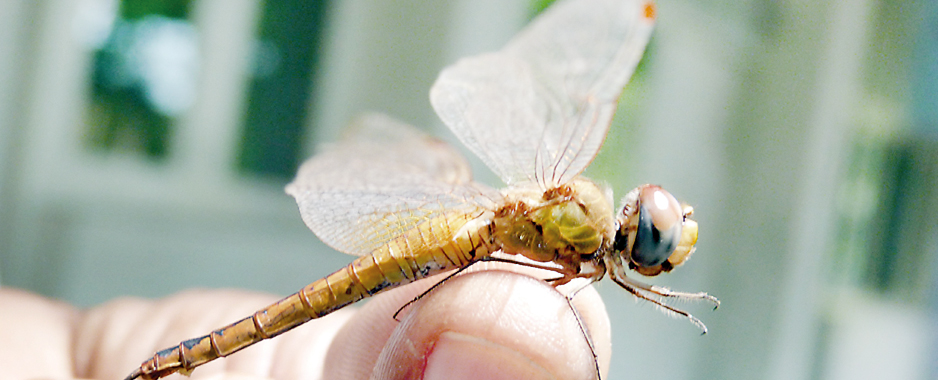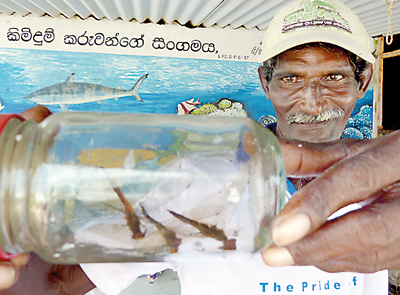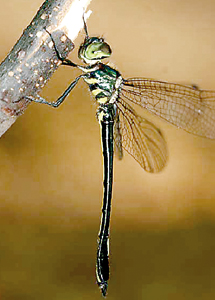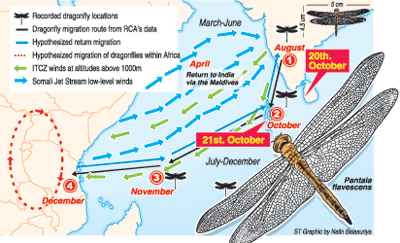News
Sri Lanka could be in path of world’s longest insect migration
Last year same period: Waves of Dragonflies were reported from the west coast and other areas. The world’s longest insect migration was documented from India-Maldives-Africa and this observation hints Sri Lanka too could be a hub in its path. Public support is sought this year to unravel this mystery…
On October 20 last year a large swarm of dragonflies were spotted in Sri Lanka’s west coast by a bird watcher Nashath Hafi. The insects had been seen heading south from areas including Moratuwa and Kollupitiya. Subsequent investigations confirmed this unusual influx of insects

A Globe Skimmer Dragonfly found last year soon after the wave of dragonflies
Speaking to the Sunday Times Sarath who lives by the coast in Dehiwela said, “the cloud of dragonflies took a few hours to pass our area. The insects were everywhere and some even ended up inside houses”. Members of the fishing community at Dehiwela helped to catch a few dragonflies that were still hovering around.
An investigation into the phenomenon by consulting biologists revealed a possibility of a mass migration of dragonflies spanning India – Maldives and all the way up to East Africa. The path covers a distance of around 14,000 kilometres and could be called the world’s longest insect migration.
Maldivian-based biologist Dr. Charles Anderson initially revealed the amazing phenomenon based onthe dates the dragonflies appear in the Maldives and India.
The Maldive Islands lack surface freshwater as the soil absorbs all rainwater. This indicated that dragonflies which spend their larvae stage in fresh water cannot breed in these tropical islands. Yet, every year millions of dragonflies appeared in the Maldives which the biologist who had been living in the islands for many years found puzzling. He also noted the insects appeared in the Maldives in October.
So Dr. Anderson investigated the concentration of dragonflies in other areas. He noted the dates dragonflies arrived in the Maldives and India demonstrated that the insects travelled from southern India –a distance of some 500 – 1000 km. Subsequent investigations also revealed an increase of dragonflies in Seychelles islands in Africa and the arrival dates in the Seychelles matched with a possible mass migration.
Dr.Anderson based on his data calculated the Dragonflies first appear in the capital city of Maldives on 21st of October on average. Quite interestingly the wave of Dragonflies was observed in Sri Lanka on 20th October highlighting the possibility that the island too was part of the path of the India-Africa dragonfly mass migration.
Checking photos of the species of dragonflies found in Sri Lanka Dr.Anderson was able to confirm it was the same species known as Globe Skimmer, or Wandering Glider, scientifically categorised as Pantala flavescens.

A Dehiwala resident showing a dragonfly caught on the beach
The biologist also noted the dates of arrival of dragonflies and occurrence coincided with the southward passage of the Inter-tropical Convergence Zone (ITCZ) which creates certain wind patterns that could assist dragonflies in their journey across oceans.
The Meteorological department confirmed the ITCZ would cross Sri Lanka next week. So it is likely that this year’s mass movement of the dragonflies could occur in next few days.
Inspired by this mass movement of dragonflies, the Field Ornithology Group of Sri Lanka (FOGSL) that studies bird migration has launched a MigrantWATCH programme.
It calls on members of the public who may notice the mass movement of dragonflies, to note down the date and time of observation, the location, the direction they fly and the approximate number of dragonflies if possible.
All data should be sent to MigrantWATCH program via email at: fogsl@slt.lk, by post: MigrantWATCH, FOGSL, Department of Zoology, University of Colombo, Colombo-03 or by telephone via Nos: 2501332/ 0712543634.
New species of dragonfly found in Sri Lanka
Sri Lanka is listed with having 118 species of dragonflies of which 43 are endemic to the country. Recently a new variety was discovered by Nancy van der Poorten – a well known researcher into dragonflies who made the discovery from Kudawa at the western edge of Sinharaja rain forest.

The new Dragonfly - Macromidia donaldi pethiyagodai
The variety belongs to a genus referred to as Macromidia. Genus is a categorization of species that has similar characteristics and this is the first time a dragonfly of this genus has been discovered from Sri Lanka.
The species similar to a species found in India’s Western Ghats is separated from its Indian cousin by a distance of 750 km and could therefore be endemic to Sri Lanka.
Researchers however point out, until certain aspects of the Indian dragonfly are studied in detail, it would not possible to confirm the differences scientifically.
Until such time the latest discovery of Dr. Nancy van der Poorten has been designated as a Sri Lankan subspecies and named Macromidia donaldi pethiyagodai, honouring Rohan Pethiyagoda who made several discoveries of new species.

Follow @timesonlinelk
comments powered by Disqus






















